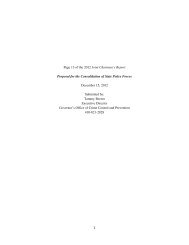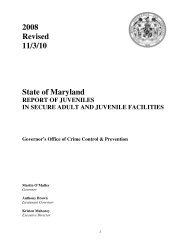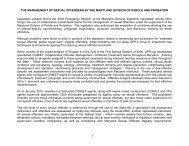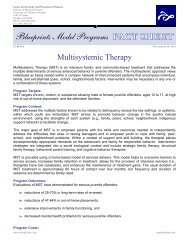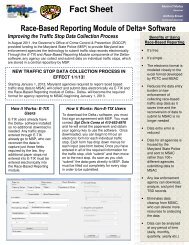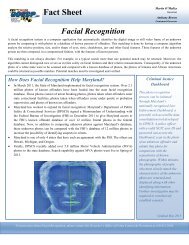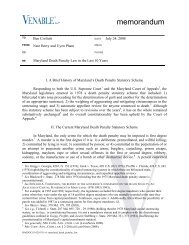The Cost of the Death Penalty in Maryland - Urban Institute
The Cost of the Death Penalty in Maryland - Urban Institute
The Cost of the Death Penalty in Maryland - Urban Institute
Create successful ePaper yourself
Turn your PDF publications into a flip-book with our unique Google optimized e-Paper software.
APPENDIX A – DATA COLLECTION<br />
<strong>The</strong> <strong>in</strong>itial data about <strong>the</strong> cases <strong>in</strong>cluded for this study are drawn from a University <strong>of</strong> <strong>Maryland</strong><br />
study on death penalty disparities <strong>in</strong> <strong>Maryland</strong> (Paternoster, Brame, Bacon & Ditchfield 2004). <strong>The</strong><br />
study exam<strong>in</strong>ed about 6,000 first and second degree murders committed <strong>in</strong> <strong>the</strong> state <strong>of</strong> <strong>Maryland</strong><br />
from August 1978 until September 1999. <strong>The</strong> <strong>in</strong>itial pool <strong>of</strong> 6,000 homicides produced a universe <strong>of</strong><br />
1,311 death sentence eligible cases. <strong>The</strong>se 1,311 cases met two criteria: 1) <strong>the</strong> state’s attorney filed a<br />
notice <strong>of</strong> <strong>in</strong>tention to seek <strong>the</strong> death penalty and 2) <strong>the</strong> facts <strong>of</strong> <strong>the</strong> case clearly complied with <strong>the</strong><br />
death penalty eligible criteria. Ambiguous cases were reviewed and <strong>the</strong> recommendations <strong>of</strong> by a<br />
panel <strong>of</strong> attorneys. <strong>The</strong> <strong>in</strong>itial list <strong>of</strong> homicides and <strong>the</strong> correspond<strong>in</strong>g case records were collected<br />
from <strong>the</strong> <strong>Maryland</strong> Division <strong>of</strong> Corrections. Additional data on case files were provided by <strong>the</strong> Clerk<br />
<strong>of</strong> <strong>the</strong> <strong>Maryland</strong> Court <strong>of</strong> Appeals, State’s Attorney <strong>of</strong>fices and <strong>the</strong> <strong>Maryland</strong> Office <strong>of</strong> Public<br />
Health. However, s<strong>in</strong>ce <strong>the</strong> study was focused on <strong>the</strong> effect <strong>of</strong> race and jurisdiction on <strong>the</strong><br />
imposition <strong>of</strong> <strong>the</strong> death penalty, time- and cost-related variables that were crucial to our study were<br />
not <strong>in</strong>cluded <strong>in</strong> <strong>the</strong> Paternoster data.<br />
We identified 84 observations <strong>in</strong> <strong>the</strong> data which were retrials <strong>of</strong> <strong>the</strong> same homicide. Each <strong>in</strong>itial<br />
trial and its subsequent retrial(s) were later condensed <strong>in</strong>to a s<strong>in</strong>gle observation, yield<strong>in</strong>g an analytical<br />
database <strong>of</strong> 1,227 observations. After remov<strong>in</strong>g cases which did not result <strong>in</strong> a guilty verdict, this<br />
adapted dataset <strong>of</strong> 1,136 death eligible cases formed <strong>the</strong> <strong>in</strong>itial dataset used by <strong>the</strong> UI research team.<br />
COLLECTING DATA FROM THE MARYLAND JUDICIARY CASE<br />
SEARCH (MDJCS) DATABASE<br />
Traditionally, <strong>Maryland</strong> counties ma<strong>in</strong>ta<strong>in</strong>ed hard copy records <strong>of</strong> each crim<strong>in</strong>al case file ei<strong>the</strong>r<br />
on location with <strong>the</strong> crim<strong>in</strong>al clerk’s <strong>of</strong>fice or at <strong>the</strong> <strong>Maryland</strong> Hall <strong>of</strong> Records <strong>in</strong> Annapolis,<br />
<strong>Maryland</strong>. In <strong>the</strong> 1990s, counties began deploy<strong>in</strong>g automated case management systems to<br />
electronically manage newly active cases <strong>in</strong> <strong>the</strong>ir counties. Ma<strong>in</strong>ta<strong>in</strong>ed on private computer<br />
networks, <strong>the</strong> public could access <strong>the</strong>se local databases only by visit<strong>in</strong>g <strong>the</strong> county clerk’s <strong>of</strong>fice.<br />
Each <strong>of</strong> <strong>the</strong> 24 counties developed <strong>the</strong>ir database autonomously and <strong>the</strong> databases evolved<br />
differentially with differences <strong>in</strong> operat<strong>in</strong>g systems, data availability and data format. In short, case<br />
records—hardcopy and electronic—were decentralized by county and data vary across counties.<br />
In March 2006, <strong>the</strong> <strong>Maryland</strong> Judiciary <strong>in</strong>itiated an onl<strong>in</strong>e database, <strong>the</strong> <strong>Maryland</strong> Judiciary Case<br />
Search (MDJCS), <strong>in</strong> an effort to provide public access to a centralized source <strong>of</strong> electronic case<br />
records. However, <strong>the</strong> constra<strong>in</strong>ts <strong>of</strong> <strong>the</strong> centralized database are identical to those <strong>of</strong> <strong>the</strong><br />
decentralized, county-level databases. Primarily, <strong>the</strong> MDJCS is limited to cases that had some<br />
activity after <strong>the</strong> year when <strong>the</strong> county where that case was adjudicated implemented its’ automated<br />
<strong>The</strong> <strong>Cost</strong> <strong>of</strong> <strong>the</strong> <strong>Death</strong> <strong>Penalty</strong> <strong>in</strong> <strong>Maryland</strong><br />
35



